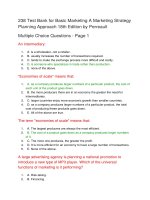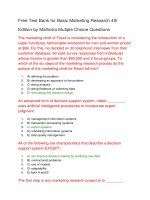146 test bank for basic marketing a strategic marketing planning approach 19th edition by perreault
Bạn đang xem bản rút gọn của tài liệu. Xem và tải ngay bản đầy đủ của tài liệu tại đây (139.13 KB, 24 trang )
146 Free Test Bank for Basic Marketing A Strategic
Marketing Planning Approach 19th Edition by Perreault
True - False Questions
Macro-marketing emphasizes the activities of individual
organizations.
1.
2.
True
False
The advantages of working with intermediaries increase as the
number of producers and customers, their distance apart, and the
number and variety of competing products increase.
1.
2.
True
False
"Economies of scale" means that as a company produces more of a
product, the cost of each unit produced goes down.
1.
2.
True
False
The universal functions of marketing are performed in the same
way in all nations and economic systems.
1.
2.
True
False
E-commerce refers to exchanges between individuals and
organizations—and the activities that facilitate those exchanges—
based on applications of information technology.
1.
2.
True
False
Intermediaries specialize in trade and production.
1.
2.
True
False
Buying, selling, transporting and storing are all universal marketing
functions.
1.
2.
True
False
"Economies of scale" prevent a company from taking advantage of
mass production.
1.
2.
True
False
An economic system is the way an economy organizes to use
scarce resources to produce goods and services and distribute
them for consumption among various people and groups in the
society.
1.
2.
True
False
The "universal functions of marketing" consist only of buying,
selling, transporting, and storing.
1.
2.
True
False
Marketing costs go down and customer satisfaction goes up in all
exchanges handled by e-commerce.
1.
2.
True
False
Marketing collaborators are any firms that provide the marketing
functions of buying and selling.
1.
2.
True
False
While intermediaries facilitate exchange, their cost makes the whole
macro-marketing system less efficient.
1.
2.
True
False
"Economies of scale" means that as a company produces more of a
product, the total cost of production goes up.
1.
2.
True
False
Responsibility for performing the marketing functions can be shifted
and shared in a variety of ways, but no function can be completely
eliminated.
1.
2.
True
False
Not all societies need an economic system.
1.
2.
True
False
Macro-marketing is a set of activities that direct an economy's flow
of goods and services from producers to consumers in a way which
effectively matches supply and demand and accomplishes the
objectives of society.
1.
2.
True
False
Effective marketing in an advanced economy is difficult because
producers and consumers are often separated in several levels.
1.
2.
True
False
In advanced societies, all goods and services can be produced with
mass production and its economies of scale.
1.
2.
True
False
Marketing functions are performed by producers, consumers, and a
variety of marketing specialists.
1.
2.
True
False
Marketing specialists such as intermediaries and collaborators
hinder the exchange process between producers and consumers.
1.
2.
True
False
Achieving effective marketing in an advanced economy is simplified
by the fact that producers are separated from consumers in only
two ways: time and space.
1.
2.
True
False
Macro-marketing is concerned with examining the relationship of
the entire production and distribution system.
1.
2.
True
False
Macro-marketing emphasizes how the whole system works, rather
than the activities of individual organizations.
1.
2.
True
False
An effective macro-marketing system matches heterogeneous
supply with heterogeneous demand.
1.
2.
True
False
The universal functions of marketing include buying, selling,
transporting, storing, standardization and grading, financing, risk
taking, and market information.
1.
2.
True
False
Compared to other innovations, firms have been relatively slow to
adopt e-commerce.
1.
2.
True
False
Only industrial nations need an economic system to decide what
and how much is to be produced and distributed by whom, when, to
whom, and why.
1.
2.
True
False
"Economies of scale" means that as a company produces larger
numbers of a particular product, the cost for each unit of the product
goes down.
1.
2.
True
False
E-commerce refers to exchanges between organizations (not
individuals) and the activities that facilitate those exchanges.
1.
2.
True
False
E-commerce refers to exchanges between individuals, but not
exchanges between organizations.
1.
2.
True
False
E-commerce refers to exchanges between organizations, but not
exchanges between individuals.
1.
2.
True
False
An effective macro-marketing system overcomes discrepancies of
quantity and discrepancies of assortment by using the universal
functions of marketing.
1.
2.
True
False
Both mass production and effective marketing are needed to satisfy
the economic needs of an advanced economy.
1.
2.
True
False
146 Free Test Bank for Basic Marketing A Strategic
Marketing Planning Approach 19th Edition by Perreault
True - False Questions - Page 2
As with any business, a nonprofit organization must take in as much
money as it spends or it won't survive.
1.
2.
True
False
The marketing concept means that an organization aims all its
efforts at satisfying its customers—at a profit.
1.
2.
True
False
In nonprofit organizations, support may not come directly from
satisfied customers.
1.
2.
True
False
A nonprofit organization does not measure profit in the same way
as a firm.
1.
2.
True
False
Whether a particular macro-marketing system is judged fair and
effective depends on the objectives of the society.
1.
2.
True
False
Market-directed economies tend to provide consumers with greater
freedom of choice than command economies.
1.
True
2.
False
During the "production era" a company focuses on production—
because few products are available in the market.
1.
2.
True
False
The marketing concept says that a firm should aim all its efforts at
satisfying customers, even if this proves to be unprofitable.
1.
2.
True
False
In a market-directed economy, price is a rough measure of how
society values particular goods and services.
1.
2.
True
False
From the Industrial Revolution until the 1920s, most companies
were in the production era.
1.
2.
True
False
Most Western economies are completely market-directed.
1.
2.
True
False
In a command economy, the individual decisions of many producers
and consumers make the macro-level decisions for the whole
economy.
1.
2.
True
False
A market-directed economy is one in which government officials
decide what and how much is to be produced and distributed by
whom, when, to whom, and why.
1.
2.
True
False
A firm that adopts the "marketing concept" will aim all its efforts at
satisfying customers, while trying to make a profit.
1.
2.
True
False
The simple trade era was a time when families traded or sold their
"surplus" output to local distributors who resold these goods to
other consumers or distant distributors.
1.
2.
True
False
In a market-directed economy, profit is guaranteed.
1.
2.
True
False
The "marketing concept" means that a firm emphasizes attracting
new customers above all other objectives.
1.
2.
True
False
The American economy and most other Western economies are
completely market-directed.
1.
2.
True
False
In a market-directed economy, government officials decide what
and how much is to be produced and distributed by whom, when, to
whom, and why.
1.
2.
True
False
The American economy is entirely market-directed.
1.
2.
True
False
The marketing concept cannot be applied to nonprofit organizations
because they are not profit-oriented.
1.
2.
True
False
In a command economy, producers generally have little choice
about what goods and services to produce.
1.
2.
True
False
In a market-directed economy, consumers enjoy complete freedom
of choice.
1.
2.
True
False
The marketing concept applies to nonprofit organizations as well as
to businesses.
1.
2.
True
False
Because they don't try to earn a profit, the marketing concept is not
very useful for nonprofit organizations.
1.
2.
True
False
During the "sales era," the firm tries to improve short-run marketing
policy planning to tie together its activities.
1.
2.
True
False
A marketing-oriented firm would try to produce what customers
want, while a production-oriented firm would try to get customers to
buy what the firm has produced.
1.
2.
True
False
Marketing departments are usually formed when firms go from the
"production era" to the "sales era."
1.
2.
True
False
The "marketing department era" is a time when all marketing
activities are brought under the control of one department.
1.
2.
True
False
During the "marketing company era," the total company effort is
guided by the idea that customers exist to buy the firm's output.
1.
2.
True
False
The term "marketing orientation" means making products that are
easy to produce and then trying to sell them.
1.
2.
True
False
A firm that makes products which are easy to produce and then
tries to sell them has a production orientation.
1.
2.
True
False
A company has moved into the "marketing company era" when, in
addition to short-run marketing planning, the total company effort is
guided by the marketing concept.
1.
2.
True
False
146 Free Test Bank for Basic Marketing A Strategic
Marketing Planning Approach 19th Edition by Perreault
True - False Questions - Page 3
Marketing ethics are the moral standards that guide marketing
decisions and actions.
1.
2.
True
False
Customer value is just another term for customer satisfaction.
1.
2.
True
False
Often the best way for a firm to beat the competition is to be first to
satisfy a need that others have not even considered.
1.
2.
True
False
Chipotle has achieved success because its customers typically view
the benefits of buying its products as greater than the costs.
1.
2.
True
False
Customer value is the difference that a customer sees between the
benefits of a firm's offering and the costs of obtaining those
benefits.
1.
2.
True
False
The three basic ideas in the marketing concept are 1) putting the
marketing manager in charge of the whole firm, 2) a competitive
orientation, and 3) an emphasis on profit.
1.
2.
True
False
When trying to build relationships with customers, salespeople must
be particularly well-trained because they are usually the only
employees whose actions influence customers directly.
1.
2.
True
False
Organizations that adopt the marketing concept should be
concerned about marketing ethics as well as broader issues of
social responsibility.
1.
2.
True
False
When a firm makes a total company effort to satisfy its customers,
and profit—not just sales—is an objective of the firm, the company
is practicing the "marketing concept."
1.
2.
True
False
A good or service that doesn't meet a consumer's needs results in
low customer value.
1.
2.
True
False
The text credits Chipotle's success to its offering good customer
value.
1.
2.
True
False
Producers who operate in a competitive environment are more
likely to adopt the marketing concept.
1.
2.
True
False
Adoption of the marketing concept is now universal.
1.
2.
True
False
The marketing concept was very quickly accepted, especially
among producers of industrial commodities like steel and glass.
1.
2.
True
False
In marketing, it is the manager's viewpoint that matters, not the
customer's.
1.
2.
True
False
Adopting the marketing concept requires that a business firm
eliminate all functional departments.
1.
2.
True
False
The text credits L.L. Bean's marketing success to its great location.
1.
2.
True
False
The American Marketing Association's statement of ethics sets
specific ethical standards for many aspects of marketing.
1.
2.
True
False
The American Marketing Association has adopted a statement of
ethics that sets specific ethical standards for many aspects of the
management job in marketing.
1.
2.
True
False
Offering superior customer value is especially important when
competition is intense.
1.
2.
True
False
The three basic ideas in the marketing concept are: 1) customer
satisfaction; 2) confining marketing activities to marketing
professionals; and 3) having profit as an objective.
1.
2.
True
False
The moral standards that guide marketing decisions and actions are
called marketing ethics.
1.
2.
True
False
It is more costly for firms to try and attract new customers than it is
to build a strong relationship with existing customers.
1.
2.
True
False
A manager who follows a production concept views customer
satisfaction as the path to profit.
1.
2.
True
False
Companies that consider the triple bottom line measure economic,
social, and political outcomes.
1.
2.
True
False
The three basic ideas included in the definition of the marketing
concept are: customer satisfaction, a total company effort, and
sales as an objective.
1.
2.
True
False
The marketing concept says that it is a firm's obligation to improve
its positive effects on society and reduce its negative effects.
1.
2.
True
False
Customer value is the difference between the benefits a customer
sees from a market offering and the costs of obtaining those
benefits.
1.
2.
True
False
A firm's obligation to improve its positive effects on society and
reduce its negative effects is called fiscal responsibility.
1.
2.
True
False
The text credits Chipotle's marketing success to its great price.
1.
2.
True
False
Moral standards often vary from one person to another, from one
society to another, and among different groups within a society, so
there is likely to be disagreement about what opinion is correct
when it comes to marketing ethics.
1.
2.
True
False
The text credits L.L. Bean's success to its focus on customer
satisfaction and good customer value.
1.
2.
True
False
L.L. Bean has achieved success because its customers typically
view the benefits of buying its products as greater than the costs.
1.
2.
True
False
Adopting the marketing concept rarely requires any change in a
firm's attitudes, organization structure, or management methods
and procedures.
1.
2.
True
False
When it comes to customer value, it is the customer's view that
matters, not the view of the marketing manager.
1.
2.
True
False
Organizations guided by a triple bottom line consider economic,
social, and environmental outcomes as measures of long-term
success.
1.
2.
True
False
The micro-macro dilemma occurs when a firm focuses its efforts on
satisfying some consumers to achieve its objectives, possibly
causing negative societal outcomes.
1.
2.
True
False
Setting a low price for a firm's offering is a sure way of creating high
customer value.
1.
2.
True
False
Low price and high customer value is one and the same thing.
1.
2.
True
False
Sometimes micro-macro dilemmas arise because what is "good" for
some producers and consumers may not be "good" for society as a
whole.
1.
2.
True
False
A manager shouldn't be criticized for making an unethical marketing
decision unless the ethical breach was intentional.
1.
2.
True
False
Gun control is an example of a micro-macro dilemma.
1.
2.
True
False
Firms that embrace the marketing concept seek ways to build a
profitable long-term relationship with each customer.
1.
2.
True
False
To develop lasting relationships with customers, marketing-oriented
firms need to focus on customer satisfaction both before and after
each sale.
1.
2.
True
False
146 Free Test Bank for Basic Marketing A Strategic
Marketing Planning Approach 19th Edition by Perreault
True - False Questions - Page 4
The micro view of marketing is mainly concerned with the activities
performed by organizations.
1.
2.
True
False
Marketing encourages the development and spread of new ideas,
goods, and services.
1.
2.
True
False
Marketing discourages the development and spread of new ideas,
goods, and services.
1.
True
2.
False
Marketing activities should begin with potential customer needs, not
with the production process.
1.
2.
True
False
Micro-marketing is a social process that directs an economy's flow
of goods and services from producers to consumers in a way that
effectively matches supply and demand and accomplishes society's
objectives.
1.
2.
True
False
Marketing is basically selling and advertising.
1.
2.
True
False
Marketing is the performance of activities that seek to accomplish
an organization's objectives by anticipating customer or client
needs and directing a flow of need-satisfying goods and services
from producer to customer or client.
1.
2.
True
False
Marketing only applies to profit organizations.
1.
2.
True
False
Customer satisfaction is the extent to which a firm fulfills a
consumer's needs, desires, and expectations.
1.
2.
True
False
Estimating what price consumers are willing to pay for a product
and if the firm can make a profit selling at that price, is an example
of a production activity.
1.
2.
True
False
Marketing can be viewed as a set of activities performed by
organizations, but not as a social process.
1.
2.
True
False
A marketing exchange is a single transaction between a firm and a
customer, nothing more.
1.
2.
True
False
In a pure subsistence economy—when each family unit produces
everything it consumes—no marketing is involved.
1.
2.
True
False
If a firm produces the right goods or services, marketing has little
role to play in creating customer satisfaction.
1.
2.
True
False
The micro view of marketing sees it as the performance of activities
that seek to accomplish an organization's objectives by anticipating
customer or client needs and directing a flow of need-satisfying
goods and services from producer to customer or client.
1.
2.
True
False
Marketing is concerned with individual transactions rather than with
building ongoing relationships with customers because that is the
job of people in the public relations department.
1.
2.
True
False
It is estimated that marketing costs about 50 percent of each
consumer's dollar.
1.
2.
True
False
From a micro view, marketing activities are performed only by profitoriented organizations.
1.
2.
True
False
Production, not marketing, should determine what products are to
be made.
1.
2.
True
False
Marketing, in the literal sense, means "selling" or "advertising."
1.
2.
True
False
Marketing can provide needed direction for production and help
make sure that the right goods and services find their way to
interested consumers.
1.
2.
True
False
In advanced economies, marketing costs only about 10 percent of
each consumer's dollar.
1.
2.
True
False
Actually making goods or performing services is called marketing.
1.
2.
True
False
According to the text, marketing means "selling" or "advertising."
1.
2.
True
False
Marketing doesn't occur unless two or more parties are willing to
exchange one item for another.
1.
2.
True
False
Marketing plays an essential role in creating customer satisfaction.
1.
2.
True
False
Marketing only applies to for-profit organizations.
1.
2.
True
False
Marketing can be viewed as a social process, but not as a set of
activities performed by organizations.
1.
2.
True
False
Marketing is both a set of activities performed by organizations and
a social process.
1.
2.
True
False
Marketing activities should be of no interest to a nonprofit
organization.
1.
2.
True
False
Marketing does not occur unless two or more parties are willing to
exchange something for something else.
1.
2.
True
False
Marketing means "promotion and selling."
1.
2.
True
False
Macro-marketing emphasizes how the whole marketing system
works.
1.
2.
True
False
Marketing does not occur unless there are two or more parties who
want to exchange something for something else.
1.
2.
True
False
Marketing should begin with the production process.
1.
2.
True
False









